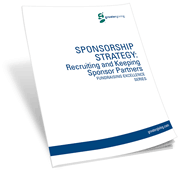
 This post is the seventh and final in a series designed to open you up to a new way of viewing sponsors and their role within your nonprofit’s overall strategy. These posts are based on the “Sponsorship Strategy: Recruiting and Keeping Sponsor Partners” eBook from the Greater Giving Fundraising Excellence Series. Each new post focuses on a different part of your sponsor strategy and how best to leverage your value for the greatest mutual benefit. View all released series articles—Sponsorship Strategies
This post is the seventh and final in a series designed to open you up to a new way of viewing sponsors and their role within your nonprofit’s overall strategy. These posts are based on the “Sponsorship Strategy: Recruiting and Keeping Sponsor Partners” eBook from the Greater Giving Fundraising Excellence Series. Each new post focuses on a different part of your sponsor strategy and how best to leverage your value for the greatest mutual benefit. View all released series articles—Sponsorship StrategiesIn Part 2 of “Pitching for a Yes,” I covered putting together all the value you have to offer, and developing it into a pitch. I also stressed rehearsing your pitch and getting feedback from internal resources.
But now the time has come. You’ve done all your homework. You’ve thought long and hard about how to present your nonprofit, and gotten comfortable with the process of pitching (by doing dry runs with your board members or staff). So what’s next?
Set the right atmosphere
Start out laying the best possible groundwork for your pitch by setting up another face-to-face meeting with the sponsor you’re courting. Only set this meeting once you’re ready to make your pitch!
Always make your ask in person, if you can, so your pitch goes with a face. It’s harder to say “no” in person, to a person—and in a face-to-face meeting, it’ll be easier to hold your potential sponsor’s attention while you deliver the whole value proposition.
Do you have anyone connected to this business? Bring that person along for the meeting where you make the ask. This person is an automatic endorsement of your organization, and even if they don’t participate much in the meeting, their presence is still meaningful.

Make it interactive
Come prepared to your meeting with two packets of materials—one containing info-graphics, which you’ll give to your potential sponsor at the beginning of the meeting. This way, they have something visual to illustrate the points you make in your pitch. The second packet you’ll wait to give them at the end of the pitch, which contains all the information you covered so they can refer back to it later.
As you deliver your pitch, leave some space to let your sponsor ask questions. Brainstorm with your team before the pitch meeting what questions might come up, and be prepared with answers. Give your sponsor time to process your information and find out more about what they want and need, so you can meet those needs.
Make the ask!
Don’t shy away from it! You can’t raise money if you don’t ask for it, so make sure to actually ask for the sponsorship dollars at the end of your pitch. Be confident, but not arrogant; your nonprofit has a lot to offer and it’s only fair to ask for equal compensation.
If you get pushback on asking for the moon, that’s okay! Take it with grace. You aren’t seeking a one-time event sponsor; you’re working towards a lifetime partnership that benefits both of you.
Come prepared with multiple sponsorship levels that you can offer, in case your potential sponsor isn’t comfortable with the initial dollar amount or commitment level. Always start high and work your way lower. Make sure that before the meeting, you already know what lower levels you want to offer, so you can ensure that the deal is still fair for both of you.
Don’t avoid the nitty-gritty
Don’t dodge the tough parts of your ask. Be clear with your sponsor about what’s required on their end—providing their own booth at the walk-a-thon, donating a certain amount of merchandise in-kind for an upcoming event, etc. Make it clear in your information packet, too, so they know what they need to provide. (This way, there are no misunderstandings later!)
Push for a decision!
I know you’re already feeling like, “Geez, but I’m asking for so much!” Don’t undervalue what you’re contributing to the transaction. It’s not unreasonable, as a business person, to ask for a decision sooner rather than later. You need to make budgeting decisions, too.
Try to get a decision in the pitch meeting if you can, but don’t apply too much pressure. If you do have to wait for a decision, make sure you get an exact date for when you can expect that decision. Follow up when that date arrives. Nudge as necessary.
Thank them for their time
No matter how your pitch  meeting goes, someone gave you of their time and energy to be there. Be appropriately grateful.
meeting goes, someone gave you of their time and energy to be there. Be appropriately grateful.
This may be only the beginning of a long relationship! Sometimes the most lucrative sponsor partnerships start with a no—perhaps the time isn’t right, the dollars aren’t available, or the sponsor needs some time to become accustomed to the idea.
Stay in touch with potential sponsors who said no. Continue to learn about them, check in with them, and let them know you’re still thinking about them. You can still foster and build a relationship that might not pay off for a few more years still.
For an in-depth look into the strategy and a detailed action plan, download the Sponsorship Strategies eBook.

